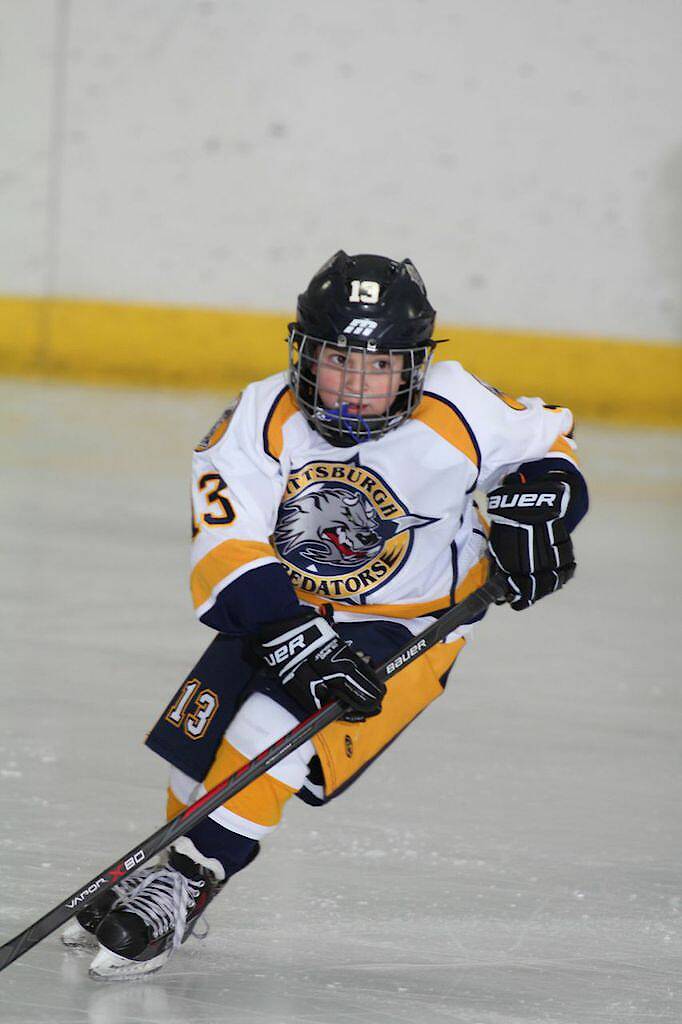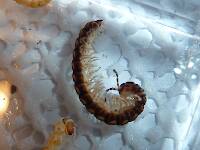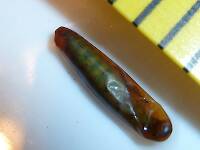
Salmonflies
Pteronarcys californica
The giant Salmonflies of the Western mountains are legendary for their proclivity to elicit consistent dry-fly action and ferocious strikes.
Featured on the forum

Troutnut is a project started in 2003 by salmonid ecologist Jason "Troutnut" Neuswanger to help anglers and
fly tyers unabashedly embrace the entomological side of the sport. Learn more about Troutnut or
support the project for an enhanced experience here.
Entoman on Sep 29, 2012September 29th, 2012, 6:59 pm EDT
Hi Fred,
Yes, the larval stage of the geometer moth or inchworm is eaten by trout. Several patterns made from dyed deer hair lashed to a hook have been popular for years. I'm partial to ultra chenille in a kind of floating version of the San Juan worm.
Yes, the larval stage of the geometer moth or inchworm is eaten by trout. Several patterns made from dyed deer hair lashed to a hook have been popular for years. I'm partial to ultra chenille in a kind of floating version of the San Juan worm.
"It's not that I find fishing so important, it's just that I find all other endeavors of Man equally unimportant... And not nearly as much fun!" Robert Traver, Anatomy of a Fisherman
Gutcutter on Sep 30, 2012September 30th, 2012, 3:57 am EDT
Fred
Not only will trout eat them, sometimes they will selectively take them.
From late July to mid September, larger trout in one of my favorite well canopied streams, will take these over just about anything else, including the ants and beetles that everybody else is throwing. For me, there is nothing better than #24 tricos on a 4wt bamboo with 7x from dawn until 9AM. Then having breakfast before I change up to a 5wt and 2x to fish the cats from 11 until I care to quit...
Some of the juicy worms present that I try to imitate:
Walnut caterpillars - Datana integerrima - black - about 2"
Tussuk moth caterpillars Orgyia leucostigma - red head/pale body - about an inch and a half
Catalpa worms Ceratomia catalpae - yellow with a black stripe - up to 3"
And those beautiful green inch worms like you have imitated.
Don't hesitate to try them on any stream where you notice them in the trees above. Trout love them.
My imitations are crude when compared to yours, but the fish smack 'em pretty well...
* Note - I'm guessing on the latin names based on my observations and, of course, Wikipedia
Not only will trout eat them, sometimes they will selectively take them.
From late July to mid September, larger trout in one of my favorite well canopied streams, will take these over just about anything else, including the ants and beetles that everybody else is throwing. For me, there is nothing better than #24 tricos on a 4wt bamboo with 7x from dawn until 9AM. Then having breakfast before I change up to a 5wt and 2x to fish the cats from 11 until I care to quit...
Some of the juicy worms present that I try to imitate:
Walnut caterpillars - Datana integerrima - black - about 2"
Tussuk moth caterpillars Orgyia leucostigma - red head/pale body - about an inch and a half
Catalpa worms Ceratomia catalpae - yellow with a black stripe - up to 3"
And those beautiful green inch worms like you have imitated.
Don't hesitate to try them on any stream where you notice them in the trees above. Trout love them.
My imitations are crude when compared to yours, but the fish smack 'em pretty well...
* Note - I'm guessing on the latin names based on my observations and, of course, Wikipedia
All men who fish may in turn be divided into two parts: those who fish for trout and those who don't. Trout fishermen are a race apart: they are a dedicated crew- indolent, improvident, and quietly mad.
-Robert Traver, Trout Madness
-Robert Traver, Trout Madness
FredH on Sep 30, 2012September 30th, 2012, 4:47 am EDT
Thanks Entoman and Gutcutter . I can't wait to tie up some of the different catapillars you mentioned and add them to my trout box.
Fred
Fred
Gutcutter on Sep 30, 2012September 30th, 2012, 5:22 am EDT
I'm partial to ultra chenille in a kind of floating version of the San Juan worm.
I have gone to (sorry, Shawn) foam.
I tie them on a sewing needle, impaling a cylinder of the approximate diameter, length and color through the center. I use Sharpie's to add the appropriate markings (more for me than the trout). Then I wrap the appendages (a dubbing loop or long palmered hackle) onto the cylinder.
I remove it from the needle, and then rig it like a rubber worm (but sticking the hook into the center of the cylinder) with a size 6 or 8 hook.
Floats like a cork and very durable.
Short strikes can be a problem with smaller fish.
I tried Carrie Stevens hooks, tying directly on the long shank, but they seem to hook fish from the outside more than the inside of the mouth.
Maybe Gonzo has a pattern to share?
All men who fish may in turn be divided into two parts: those who fish for trout and those who don't. Trout fishermen are a race apart: they are a dedicated crew- indolent, improvident, and quietly mad.
-Robert Traver, Trout Madness
-Robert Traver, Trout Madness
PaulRoberts on Sep 30, 2012September 30th, 2012, 5:54 am EDT
Like Tony, I found little fluorescent chartreuse inchworms to be selected for by forest stream trout in both NY and PA. Just the color could do it, and trout would leave their lies to take them!
My best Hammersley Fork trout, taken years ago well up the fork, came on an inchworm imitation, although I didn't immediately recognize that. The 14" brown came a distance to take my Panther Martin #1 with a bright yellow "tail fly", intercepting it just as it touched down. The aggressive take surprised me. We ate that fish (sorry to say now) and found its stomach full of inchworms. The take was so zealous, it was obvious what it thought it saw, and was one of my earliest examples of "selectivity", or better -"target image"- on small streams.
I tie two: a thread fly tied with fluor. chartreuse nylon that sinks quicker, and one of charteuse micro-chenille.
My best Hammersley Fork trout, taken years ago well up the fork, came on an inchworm imitation, although I didn't immediately recognize that. The 14" brown came a distance to take my Panther Martin #1 with a bright yellow "tail fly", intercepting it just as it touched down. The aggressive take surprised me. We ate that fish (sorry to say now) and found its stomach full of inchworms. The take was so zealous, it was obvious what it thought it saw, and was one of my earliest examples of "selectivity", or better -"target image"- on small streams.
I tie two: a thread fly tied with fluor. chartreuse nylon that sinks quicker, and one of charteuse micro-chenille.
Entoman on Sep 30, 2012September 30th, 2012, 9:11 am EDT
Tony -
Foam is a great idea! Besides floatation, it does a great job of matching the segmentation of the natural and has a great mouth-feel. Never liked the deer hair patterns, too stick-like.
You're right about the significance of the canopy, especially deciduous. We don't get a lot of that out here, but there are stretches of the Sacramento and McCloud and especially Putah Creek that fit the category. I've found them to be fairly inconsistent. Some years are great, others you never seem to see them. I remember a tannish brown one about the thickness of a match stick and maybe 3/4" long that was profuse on the Truckee years ago. The bushes were crawling with them for about a week or so and the trout were stuffed. Haven't seen them since.
Yes, I've noticed the same thing when experimenting with them for salmonfly patterns. On the swing, no problem. But dead drift? Ha! Missed fish, fish hooked on top of the head (and worse) have all happened to me. Have you tried 2xl dry fly hooks, and keeping the extended body no longer than gap width? It really helps reduce missed fish on big drake patterns. I think maybe it would help with your caterpillars as well?
BTW - You don't need to use cylinder foam. The flat foam will round out perfectly (especially the butt) and you aren't so limited in size and color selection. Cut a strip the width required for matching the bulk of the natural and stick it on the middle over the needle. Fold the ends over and tie down with four or five wraps of thread already started. Fold the ends back and advance the tread forward on the needle one segment width. Fold the ends forward again and tie down with four or five wraps. Repeat the process until you have the length you want (hook gap). Whip finish, leaving both tag ends (the start and whip finish tags) sticking out over the front. These will be lashed to the shank of the hook. Fine super threads seem to work best for this step as they slip off the needle easier. Fold the ends back and tie in the thread tags on the hook shank right up against where they emanate from the foam. Finish off the segs on the hook just as you did on the needle, only the flaps are on the sides of the hook to avoid the point.
Foam is a great idea! Besides floatation, it does a great job of matching the segmentation of the natural and has a great mouth-feel. Never liked the deer hair patterns, too stick-like.
You're right about the significance of the canopy, especially deciduous. We don't get a lot of that out here, but there are stretches of the Sacramento and McCloud and especially Putah Creek that fit the category. I've found them to be fairly inconsistent. Some years are great, others you never seem to see them. I remember a tannish brown one about the thickness of a match stick and maybe 3/4" long that was profuse on the Truckee years ago. The bushes were crawling with them for about a week or so and the trout were stuffed. Haven't seen them since.
Short strikes can be a problem with smaller fish.
I tried Carrie Stevens hooks, tying directly on the long shank, but they seem to hook fish from the outside.
Yes, I've noticed the same thing when experimenting with them for salmonfly patterns. On the swing, no problem. But dead drift? Ha! Missed fish, fish hooked on top of the head (and worse) have all happened to me. Have you tried 2xl dry fly hooks, and keeping the extended body no longer than gap width? It really helps reduce missed fish on big drake patterns. I think maybe it would help with your caterpillars as well?
BTW - You don't need to use cylinder foam. The flat foam will round out perfectly (especially the butt) and you aren't so limited in size and color selection. Cut a strip the width required for matching the bulk of the natural and stick it on the middle over the needle. Fold the ends over and tie down with four or five wraps of thread already started. Fold the ends back and advance the tread forward on the needle one segment width. Fold the ends forward again and tie down with four or five wraps. Repeat the process until you have the length you want (hook gap). Whip finish, leaving both tag ends (the start and whip finish tags) sticking out over the front. These will be lashed to the shank of the hook. Fine super threads seem to work best for this step as they slip off the needle easier. Fold the ends back and tie in the thread tags on the hook shank right up against where they emanate from the foam. Finish off the segs on the hook just as you did on the needle, only the flaps are on the sides of the hook to avoid the point.
"It's not that I find fishing so important, it's just that I find all other endeavors of Man equally unimportant... And not nearly as much fun!" Robert Traver, Anatomy of a Fisherman
PaulRoberts on Sep 30, 2012September 30th, 2012, 9:17 am EDT
Tony -
Foam is a great idea!
Short strikes can be a problem with smaller fish.
I tried Carrie Stevens hooks, tying directly on the long shank, but they seem to hook fish from the outside.
Yes, I've noticed the same thing when experimenting with them for salmonfly patterns. On the swing, no problem. But dead drift?
I wonder if this doesn't have to do with the unatural buoyancy of foam. Fish expect to inhale only so much, and the foam doesn't get in.
Entoman on Sep 30, 2012September 30th, 2012, 10:06 am EDT
Could be Paul, but I'm more inclined to blame the exaggerated shank length. The extended body doesn't help, either. I have fished long shank hooks (6x long and longer) on classic streamer patterns in Maine lakes and ponds for I don't know how many hundreds of hours and discovered they hook fairly well on a fast moving fly and not so well on a slow moving one. Especially if they hit during a pause in the retrieve. Below a certain retrieve speed you start missing a lot of fish. The difference is quite dramatic. For leeches and some marabou streamers designed to fish slower, 3X long hooks or shorter avoid this problem.
"It's not that I find fishing so important, it's just that I find all other endeavors of Man equally unimportant... And not nearly as much fun!" Robert Traver, Anatomy of a Fisherman
PaulRoberts on Sep 30, 2012September 30th, 2012, 1:02 pm EDT
Interesting.
Martinlf on Aug 22, 2013August 22nd, 2013, 6:22 pm EDT
Cut a strip the width required for matching the bulk of the natural and stick it on the middle over the needle. Fold the ends over and tie down with four or five wraps of thread already started. Fold the ends back and advance the tread forward on the needle one segment width. Fold the ends forward again and tie down with four or five wraps. Repeat the process until you have the length you want (hook gap). Whip finish, leaving both tag ends (the start and whip finish tags) sticking out over the front. These will be lashed to the shank of the hook. Fine super threads seem to work best for this step as they slip off the needle easier. Fold the ends back and tie in the thread tags on the hook shank right up against where they emanate from the foam. Finish off the segs on the hook just as you did on the needle, only the flaps are on the sides of the hook to avoid the point.
Huh?
Kurt I'm probably just being thick, but could you post up a photo of a middle and ending step?
"He spread them a yard and a half. 'And every one that got away is this big.'"
--Fred Chappell
--Fred Chappell
Entoman on Aug 22, 2013August 22nd, 2013, 11:06 pm EDT
No, you're not being thick, Louis. The fault lies with the poorly written explanation. Reading it this many months later confuses even the author! :)
Rather than trying to reword that mess, I'll tie some up tomorrow and take a few photos as you suggest.
Rather than trying to reword that mess, I'll tie some up tomorrow and take a few photos as you suggest.
"It's not that I find fishing so important, it's just that I find all other endeavors of Man equally unimportant... And not nearly as much fun!" Robert Traver, Anatomy of a Fisherman
Feathers5
Posts: 287
Posts: 287
Feathers5 on Aug 23, 2013August 23rd, 2013, 5:48 am EDT
Easier and just as effective you can buy inchworm foam in a pack. All you gotta do is tie it to the shank of the hook. It works for me, and I've done well on Spring Creek with it.
I have never tied the large size caterpillars Tony ties, but they do work. I've seen it myself.
Bruce
I have never tied the large size caterpillars Tony ties, but they do work. I've seen it myself.
Bruce
Entoman on Aug 26, 2013August 26th, 2013, 1:13 pm EDT
Sorry for the delay, Louis. Doing this with a hand held iPad turned out to be a little more problematic than I first thought. :) Since I had to tie a bunch of hoppers, I used them for the example. An inch worm would use a much slenderer piece of foam. This technique is good for hexes, green drakes and big stoneflies as well.
Foam stuck on the bodkin (gink the needle in front of the foam).

First seg with five wraps (don't pull too tight).

Move forward on the shank with wraps of thread over the tag to the distance required for the seg thickness (while holding the foam back). When making the segs, make sure to bring the thread up from the middle underneath to avoid trapping the corners.
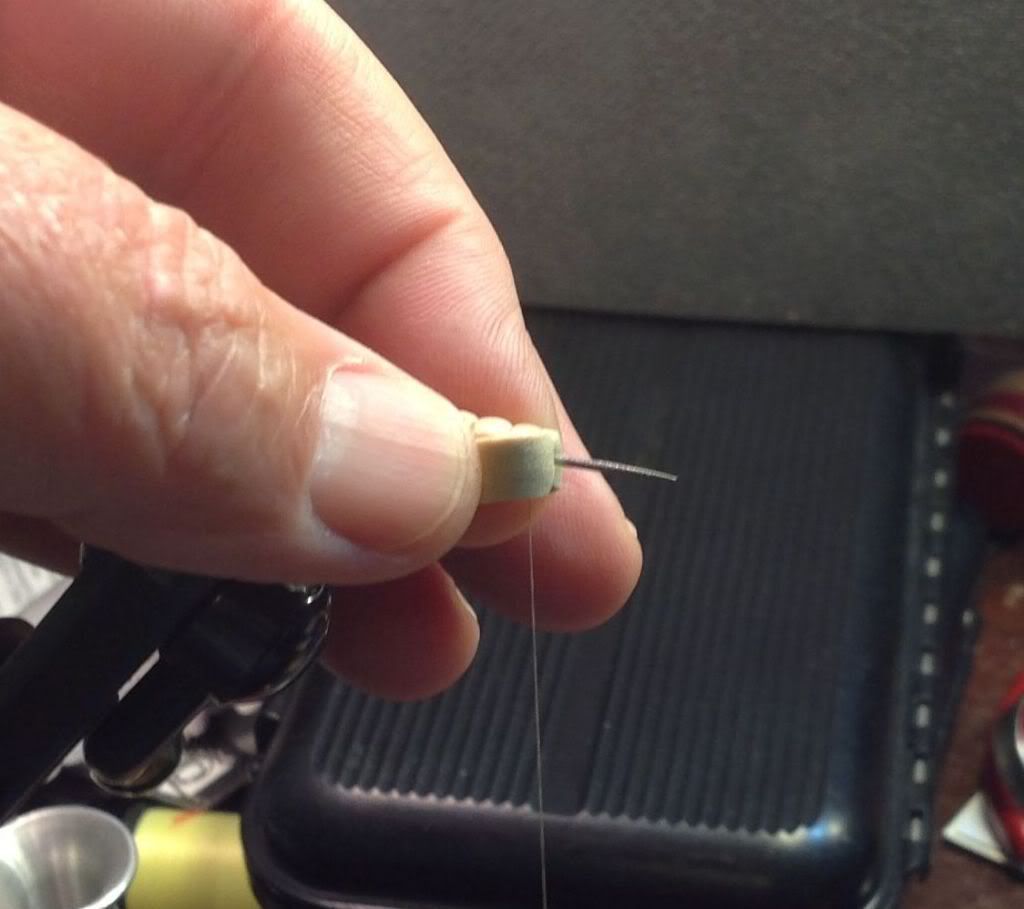
After the number of segs you want are on the bodkin, hold back the foam ends and whip finish (leaving both tags). Apply some cement on the knot and slide it off the bodkin befor it dries. I'll tie these by the dozens and leave them in little plastic bags for later use. I don't do this with the hopper bodies, but you can roll them on a flat surface to really round them.

Hold them over the shank like this and tie in the tags. Continue making segs as you did on the bodkin only now it is on the hook shank.
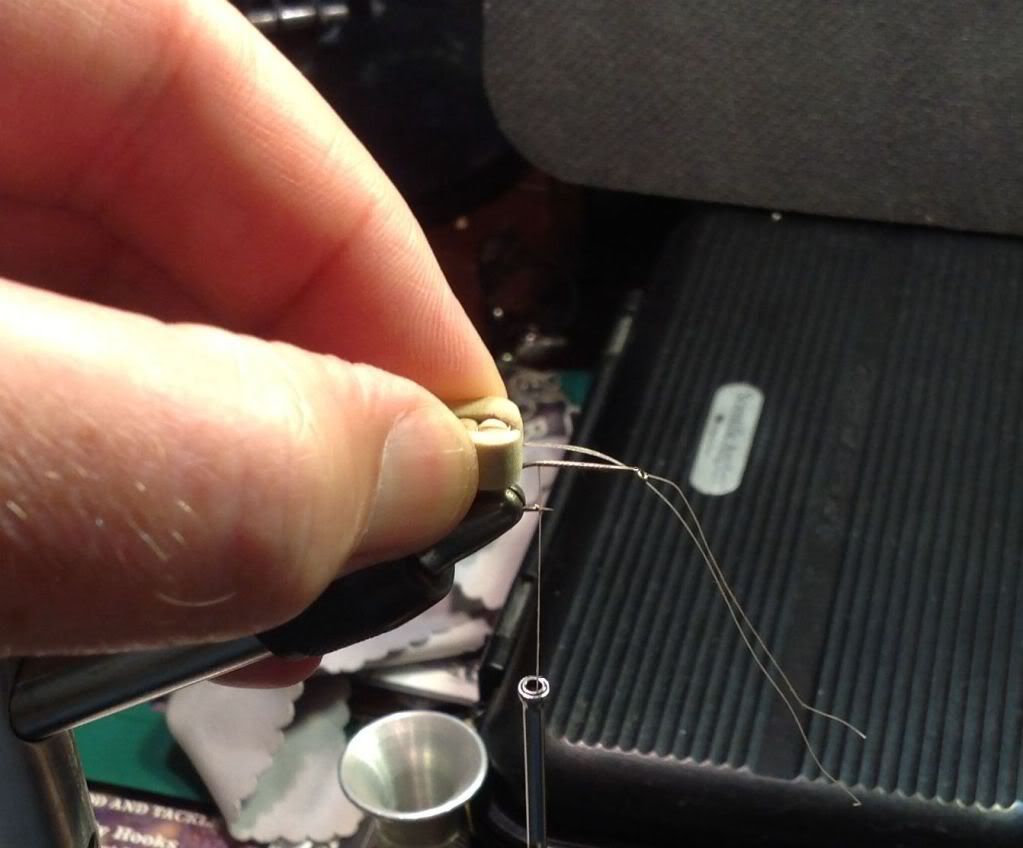
Foam stuck on the bodkin (gink the needle in front of the foam).

First seg with five wraps (don't pull too tight).

Move forward on the shank with wraps of thread over the tag to the distance required for the seg thickness (while holding the foam back). When making the segs, make sure to bring the thread up from the middle underneath to avoid trapping the corners.

After the number of segs you want are on the bodkin, hold back the foam ends and whip finish (leaving both tags). Apply some cement on the knot and slide it off the bodkin befor it dries. I'll tie these by the dozens and leave them in little plastic bags for later use. I don't do this with the hopper bodies, but you can roll them on a flat surface to really round them.

Hold them over the shank like this and tie in the tags. Continue making segs as you did on the bodkin only now it is on the hook shank.

"It's not that I find fishing so important, it's just that I find all other endeavors of Man equally unimportant... And not nearly as much fun!" Robert Traver, Anatomy of a Fisherman
Entoman on Aug 26, 2013August 26th, 2013, 1:18 pm EDT
Bruce,
There are several issues with the round foam - poor color and size selection, it's expensive (for the amount you get), and you can't segment it. I don't use it for those reasons. It makes good ants, but so does the flat foam. It (flat foam) comes in a multitude of colors and is incredibly cheap. You can cut a section to match any size and shape you need.
There are several issues with the round foam - poor color and size selection, it's expensive (for the amount you get), and you can't segment it. I don't use it for those reasons. It makes good ants, but so does the flat foam. It (flat foam) comes in a multitude of colors and is incredibly cheap. You can cut a section to match any size and shape you need.
"It's not that I find fishing so important, it's just that I find all other endeavors of Man equally unimportant... And not nearly as much fun!" Robert Traver, Anatomy of a Fisherman
Martinlf on Aug 26, 2013August 26th, 2013, 4:41 pm EDT
OK, now I get it. Thanks! It's always fun to learn a new tying technique.
"He spread them a yard and a half. 'And every one that got away is this big.'"
--Fred Chappell
--Fred Chappell
Quick Reply
Related Discussions
Topic
Replies
Last Reply
3
Jan 16, 2007
by Martinlf
by Martinlf






